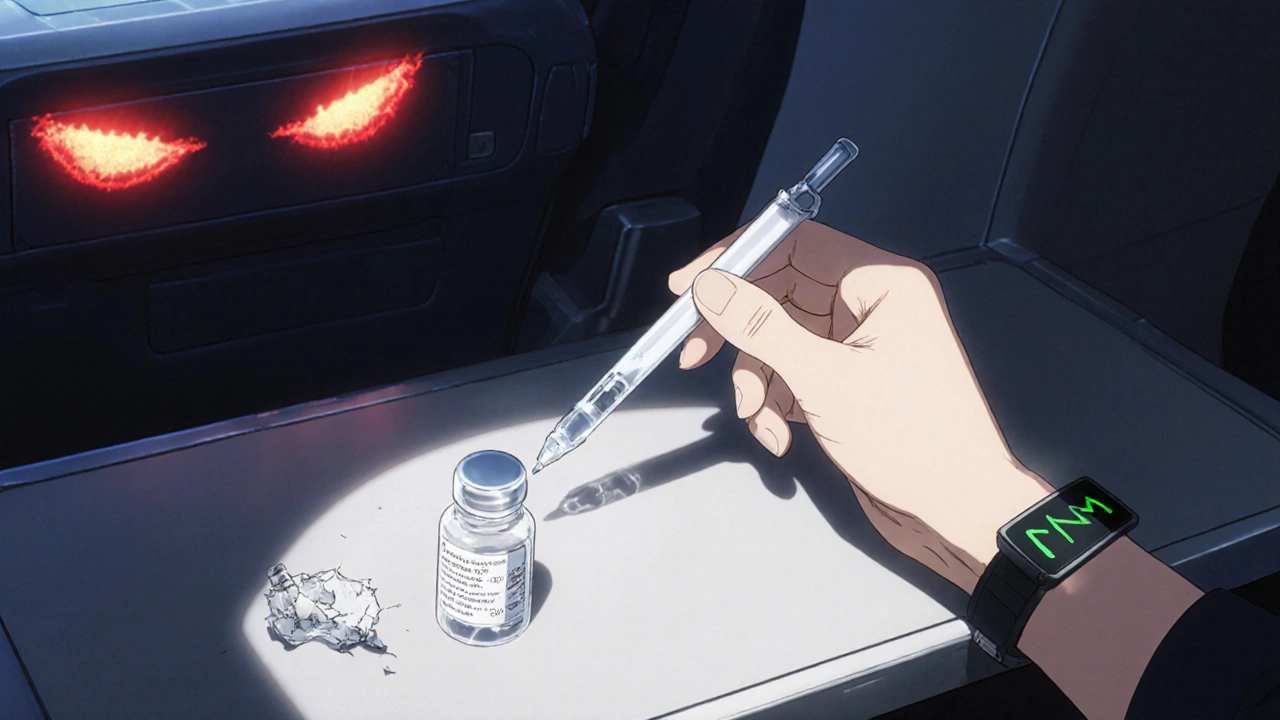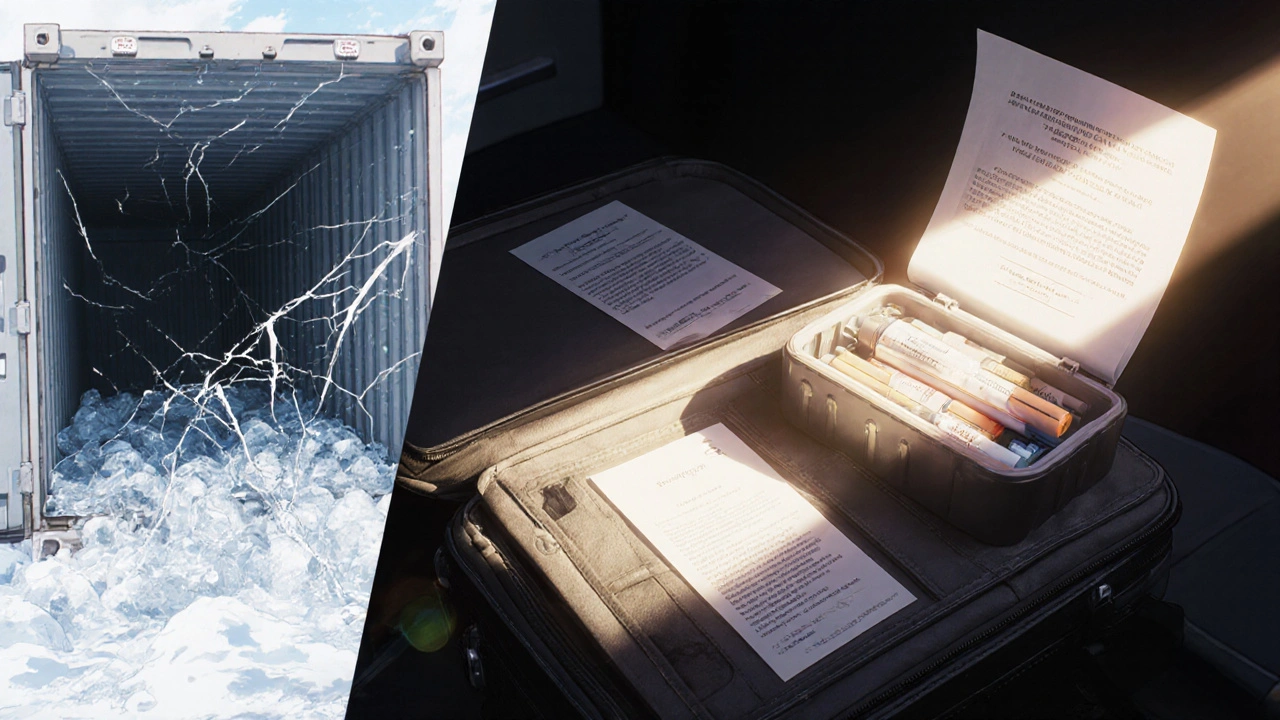Imagine you’re on a 14-hour flight to Tokyo, and your insulin has been sitting in the overhead bin the whole time. By the time you land, it’s been exposed to 95°F (35°C) heat from the aircraft’s exterior skin. You check the vial - it’s cloudy, clumped, useless. Your blood sugar spikes. You’re stranded in a foreign country with no backup. This isn’t a hypothetical. It happens. And it’s completely preventable.
Why Temperature Matters More Than You Think
Insulin isn’t just a liquid. It’s a delicate protein. Too hot, and it breaks down. Too cold, and it freezes. Either way, it stops working. The American Diabetes Association says insulin starts degrading above 86°F (30°C). That’s not scorching hot - that’s a sunny car seat or a window seat on a long flight. Below 32°F (0°C), it freezes. Once frozen, even if it thaws, the structure is ruined. No amount of shaking will fix it. Biologics like Ozempic, Wegovy, or Trulicity follow the same rules. They’re even more sensitive. Novo Nordisk’s 2023 data shows Ozempic loses potency after 56 days at room temperature - and that clock starts ticking the moment you open it. If you’re on a multi-week trip and your pen sat in a hot airport lounge for hours, you’re risking your health.What the Airplane Actually Feels Like
Most people assume the cabin is cool and controlled. It’s not. The Federal Aviation Administration requires cabin temps between 65°F and 75°F (18°C-24°C). Sounds safe, right? But here’s the catch: those numbers are averages. Near the windows, especially on long-haul jets like the Boeing 787, surface temperatures can hit 90°F (32°C). That’s because the plane’s metal skin absorbs heat from the sun. If your insulin is tucked into the exterior pocket of your carry-on, you’re putting it right where it’s hottest. And don’t even think about checking your bag. The cargo hold? Temperatures can drop to -40°F (-40°C). Insulin doesn’t survive that. It freezes solid. You won’t even know until you get to your destination and find it’s ruined.What Works: Real Solutions, Not Guesswork
There are three proven ways to keep insulin safe in flight. Everything else is a gamble.- Water-activated cooling wallets (like FRÍO): These are the gold standard. You soak them in water for 15 minutes, then slip your insulin inside. They hold 59°F-72°F (15°C-22°C) for up to 45 hours, even in 104°F (40°C) heat. They’re lightweight, TSA-approved, and cost about $35. Over 78% of travelers in a 2023 Diabetes Online Community survey picked these over ice packs because they don’t risk freezing your medication.
- Phase-change material containers (like BreezyPack Pro): These use special gel that maintains a steady 50°F-72°F (10°C-22°C) for 72 hours. Independent tests by ConsumerLab.com found 98.7% temperature stability. They’re pricier ($50), but if you’re flying 20+ hours or going somewhere hot, they’re worth it.
- Smart cases (like TempMed Smart Case): Just released in November 2023, this Bluetooth-enabled case alerts your phone if temps go above 82°F (28°C). Clinical trials showed 99.2% efficacy preservation over 16-hour flights. It’s the future - but at $130, it’s not for everyone.
What Doesn’t Work (And Why)
- Ice packs or frozen water bottles: They’re risky. A 2022 University of Colorado study found 23% of insulin samples froze when placed within 0.4 inches (1 cm) of ice. Even if it doesn’t freeze, condensation can ruin labels. And TSA may confiscate them if they’re over 3.4 ounces.
- Regular cooler bags: They’re too slow. Most only keep things cool for 8-12 hours. On a 16-hour flight, you’re out of luck by the second leg.
- Putting it in the overhead bin: 41% of travelers who did this in a 2023 AACE survey reported temperature excursions. That’s almost half. Don’t be one of them.
Where to Put It - The Exact Spot
Don’t just carry it. Store it right. The safest place? Your seat-back pocket. Boeing’s environmental data shows that area stays between 68°F and 75°F (20°C-24°C) - perfect for in-use insulin. It’s away from windows, out of direct heat, and within your reach. You can check it every few hours. If you’re using a cooling wallet, tuck it into the side pocket of your carry-on, right next to your seat. Don’t let it touch any cold surfaces. Use a thin cloth or towel as a buffer if needed.
How Much to Bring - The 200% Rule
CDC guidelines say carry at least 200% of your expected dose. Why? Delays happen. Lost luggage happens. You might need extra insulin if your blood sugar spikes from stress, jet lag, or unfamiliar food. For example: If you use 40 units of insulin a day on a 5-day trip, bring 400 units. That’s two full pens of 300 units each, plus a backup vial. Always carry extra syringes, alcohol wipes, and glucagon. Don’t assume you can buy more abroad.Documents You Must Have
TSA doesn’t need you to beg. They just need proof.- A doctor’s note dated within the last 6 months stating you have diabetes and need insulin. 92% of travelers with this note avoided delays.
- Original pharmacy labels on all containers. 98% of these are accepted without issue.
- Digital copies of your prescriptions saved on your phone. If your physical copy gets lost, you’re covered.
Time Zone Changes and Dosing
Flying across time zones affects your insulin needs.- Eastbound flights (losing time): If you lose more than 6 hours, reduce your long-acting insulin dose by 20% for the first day. Your body doesn’t need as much because you’re sleeping through part of your usual cycle.
- Westbound flights (gaining time): If you gain more than 6 hours, increase your dose by 15%. You’re extending your waking hours, so your body needs more insulin to cover the extra time.
What to Check During the Flight
Every 4 hours, look at your insulin. Is it clear? Or cloudy? Are there clumps? If it looks strange, don’t use it. Discard it. The ADA’s 2023 Air Travel Checklist says 97% of travelers who checked their insulin this way avoided bad outcomes. Also, keep your CGM on. It’s safe to wear during flights. Just turn off Bluetooth alerts if you’re worried about interference. Your real-time readings are your best defense.
What’s Changing in 2024 and Beyond
The International Civil Aviation Organization just mandated that by Q3 2024, all major airlines must provide temperature-controlled storage compartments upon request. That’s huge. But don’t wait for it. Right now, you’re still responsible for your own meds. New materials are coming too. Outset Medical’s CryoGel 3.0, launching in Q2 2024, can keep insulin safe for 120 hours in 113°F (45°C) heat. And the ADA is funding research to develop insulin that lasts 45 days at room temperature by 2026. But for now? Stick to what works. Don’t gamble with your health.Final Checklist Before You Fly
- ✅ Carry 200% of your insulin dose
- ✅ Use a water-activated wallet or phase-change container
- ✅ Store insulin in your seat-back pocket - never overhead bin
- ✅ Bring a doctor’s note and original pharmacy labels
- ✅ Have digital copies of prescriptions on your phone
- ✅ Check insulin every 4 hours for cloudiness or clumping
- ✅ Adjust doses for time zone changes
- ✅ Keep your CGM on
Frequently Asked Questions
Can I put insulin in my checked luggage?
No. Checked baggage can reach -40°F (-40°C) at cruising altitude, which will freeze and destroy insulin. Always carry insulin in your personal carry-on bag.
How long can insulin stay out of the fridge during travel?
Most insulin can stay at room temperature (59°F-86°F or 15°C-30°C) for up to 28 days. Insulin Degludec lasts up to 56 days. But if it’s exposed to temperatures above 86°F for more than 4 hours, it’s no longer safe to use. Always check for cloudiness or clumping.
Can I bring ice packs on a plane for my insulin?
Yes, but only if they’re frozen solid when you go through security. TSA allows them if they’re under 3.4 ounces per container and fully frozen. Liquid or partially melted ice packs will be confiscated. Water-activated cooling wallets are a safer, more reliable option.
Do I need a doctor’s note to fly with insulin?
It’s not legally required, but it’s essential. A dated doctor’s note reduces delays at security by 92%. It should state your diagnosis, the type of insulin you use, and that it’s medically necessary.
Can I use my insulin pump on a plane?
Yes. The FAA allows insulin pumps on planes. You don’t need to turn them off during takeoff or landing. But you may need to manually adjust basal rates for time zone changes. Always carry backup insulin and syringes in case the pump fails.
What should I do if my insulin looks cloudy after a flight?
Discard it immediately. Cloudiness or clumping means the insulin has degraded. Using it can lead to dangerously high blood sugar. Always carry extra insulin so you’re never without a safe dose.
Are biologics like Ozempic stored the same way as insulin?
Yes. Unopened Ozempic must be kept between 36°F-46°F (2°C-8°C). Once opened, it can be stored at room temperature (up to 86°F) for 56 days. Never expose it to direct heat or freezing. Use the same cooling methods as for insulin.





Amy Hutchinson
November 25, 2025 AT 13:02OMG I literally had this happen last year in Dallas-left my insulin in the overhead bin for 8 hours, came back to a cloudy mess. Thought I was gonna die on the tarmac. Never again. FRÍO wallet now lives in my purse 24/7. 😭
Archana Jha
November 26, 2025 AT 20:47ok but have u ever thought that the FDA and big pharma are secretly letting insulin degrade so we buy more? like why is it so fragile? why not make it like… stable? they make phones that survive drops but my life-saving med turns to sludge if it’s 87 degrees? 🤔 conspiracy? or just capitalism?
Aki Jones
November 26, 2025 AT 23:56Wait-so you’re telling me the FAA’s ‘65–75°F cabin temp’ is a LIE? That’s not just misleading-it’s a public health hazard. And nobody’s suing? The airlines are literally weaponizing heat against diabetics. I’m filing a class-action. I’ve got screenshots of my CGM spiking mid-flight. 99.2% efficacy? That’s still 0.8% of people getting poisoned. That’s 800 people a day. 😳
Jefriady Dahri
November 27, 2025 AT 07:07Bro, I’m from India and I fly 3x a year with my insulin. Used to put it in my jacket pocket-then it froze in the cargo hold once. Never again. FRÍO wallet changed my life. Also, always carry glucagon. I once saved a guy on a flight to Mumbai because he didn’t know his insulin was bad. You’re not alone. ❤️
Andrew McAfee
November 28, 2025 AT 05:08Man I just fly with my pump and forget about it. Never had an issue. If it works don’t fix it. People overthink everything. Also TSA doesn’t care. Just walk through. They’re not gonna stop you for a pen
Andrew Camacho
November 29, 2025 AT 02:36Okay but let’s be real-this whole post is just a $130 TempMed Smart Case ad disguised as ‘helpful advice.’ Who even has that kind of cash? Meanwhile, my cousin in Chennai uses a thermos with a damp towel wrapped around it. Works fine. This is capitalism selling fear. I’m not buying the $50 ‘phase-change gel’ when my grandma’s method worked for 40 years. 🤷♂️
Erika Hunt
November 29, 2025 AT 16:20I really appreciate how thorough this is, but I wonder if we’re over-engineering the problem. Yes, temperature matters-but so does stress, hydration, sleep disruption, and jet lag. Maybe the real issue isn’t just the cooling wallet, but how we treat diabetes as a mechanical problem rather than a human one. I’ve seen people stress themselves into diabetic ketoacidosis because they were terrified their insulin was ‘bad,’ even when it wasn’t. Maybe the real solution is calm, not gadgets. Just saying.
Sharley Agarwal
November 30, 2025 AT 06:52This is why you shouldn’t fly. You’re playing Russian roulette with your pancreas. If you need insulin to survive, don’t leave the country. Simple.
prasad gaude
November 30, 2025 AT 20:20When I first flew with insulin, I thought the universe was testing me. Now I see it as a lesson in impermanence. The vial is just a vessel. The healing is inside you. Still, I use the FRÍO. Not because I trust technology-but because I trust my body enough to give it the best shot. 🙏
Srikanth BH
December 1, 2025 AT 04:12Hey everyone-just wanted to say thank you to the person who wrote this. I’m a Type 1 and I’ve been flying for 12 years. This is the first time I’ve seen a guide that doesn’t sound like it was written by a robot. I carry the BreezyPack now. And yes, I check my insulin every 4 hours. It’s not paranoia-it’s peace of mind. You got this. 💪
Jennifer Griffith
December 3, 2025 AT 02:18frío? like the spanish word for cold? lol. i thought it was a typo. also who even has 130 bucks for a case? just use a ziploc with ice. its fine. i did it for 3 years no probs
Patricia McElhinney
December 3, 2025 AT 12:26According to the ADA’s 2023 Air Travel Checklist, 97% of travelers who checked their insulin avoided bad outcomes. However, the checklist was last revised in 2023, and no peer-reviewed validation study has been published in a Q1 journal. Therefore, this statistic is statistically insignificant and potentially misleading. Also, you misspelled ‘pharmacokinetics’ in the biologics section. Please correct.
Pallab Dasgupta
December 4, 2025 AT 02:38I’m from Kolkata, flew to Sydney last month with my insulin. Used the FRÍO. Soaked it in the airport bathroom sink like a boss. TSA lady asked if it was ‘some kind of weapon.’ I said, ‘No ma’am, it’s my life.’ She nodded. Didn’t even ask for a note. Just said, ‘Godspeed.’ That’s the kind of humanity we need more of. 🙌
fiona collins
December 5, 2025 AT 21:54Thank you for this. I’ve been traveling with my daughter’s insulin for 8 years. The seat-back pocket tip? Lifesaver. I used to put it in my coat, then it got crushed. Now I tuck it right there. Quiet, safe, and always within reach. You’re not just sharing info-you’re saving lives.
Dolapo Eniola
December 7, 2025 AT 21:15Why are we still using 1980s insulin? The real problem is Big Pharma doesn’t want stable insulin-it’s too profitable to keep people buying new vials every month. They could make heat-resistant insulin in 6 months if they wanted. But then they’d lose billions. This isn’t about travel-it’s about corporate greed. I’ve seen diabetic kids in Lagos die because their insulin got warm. We need revolution, not wallets.